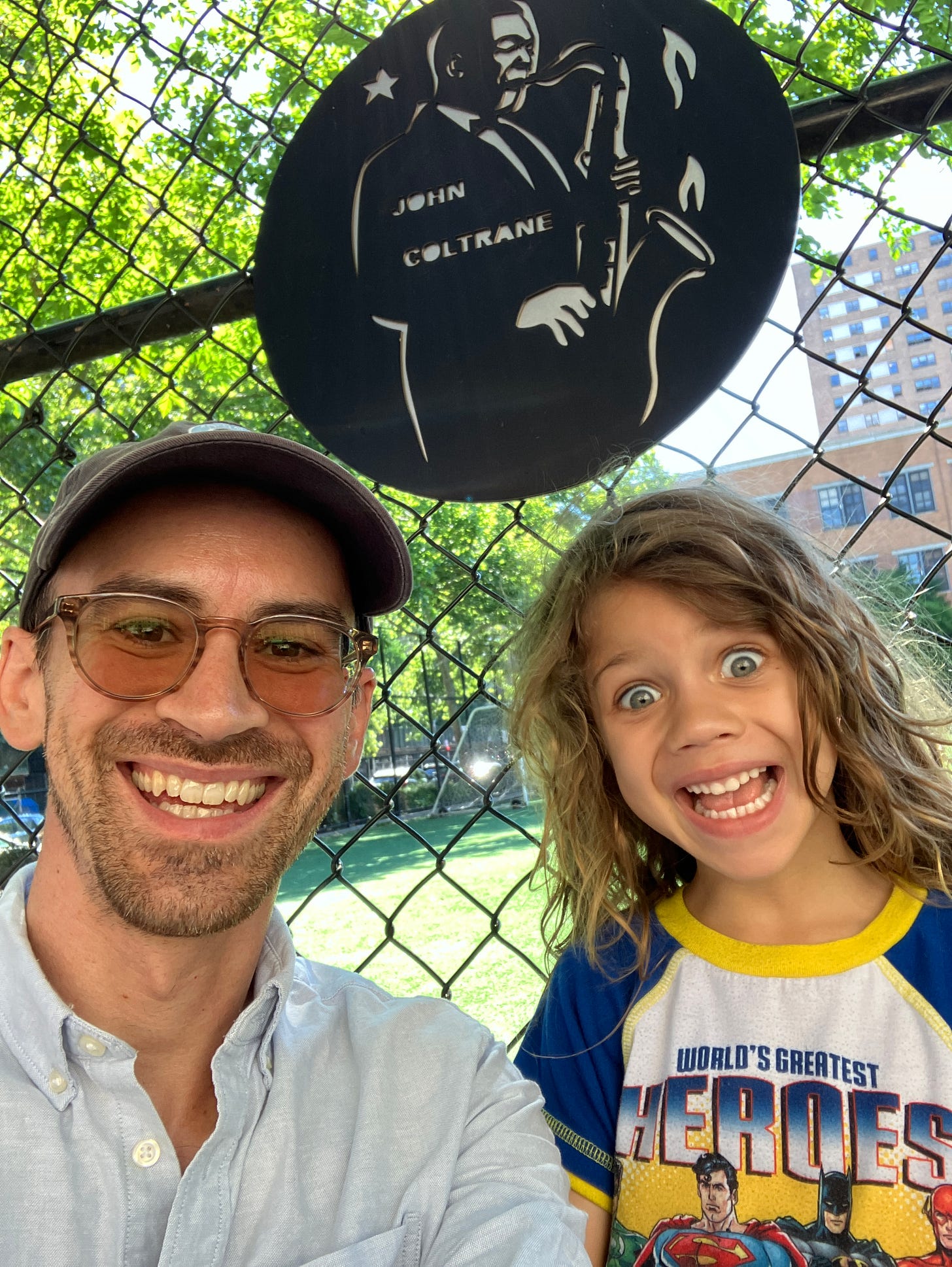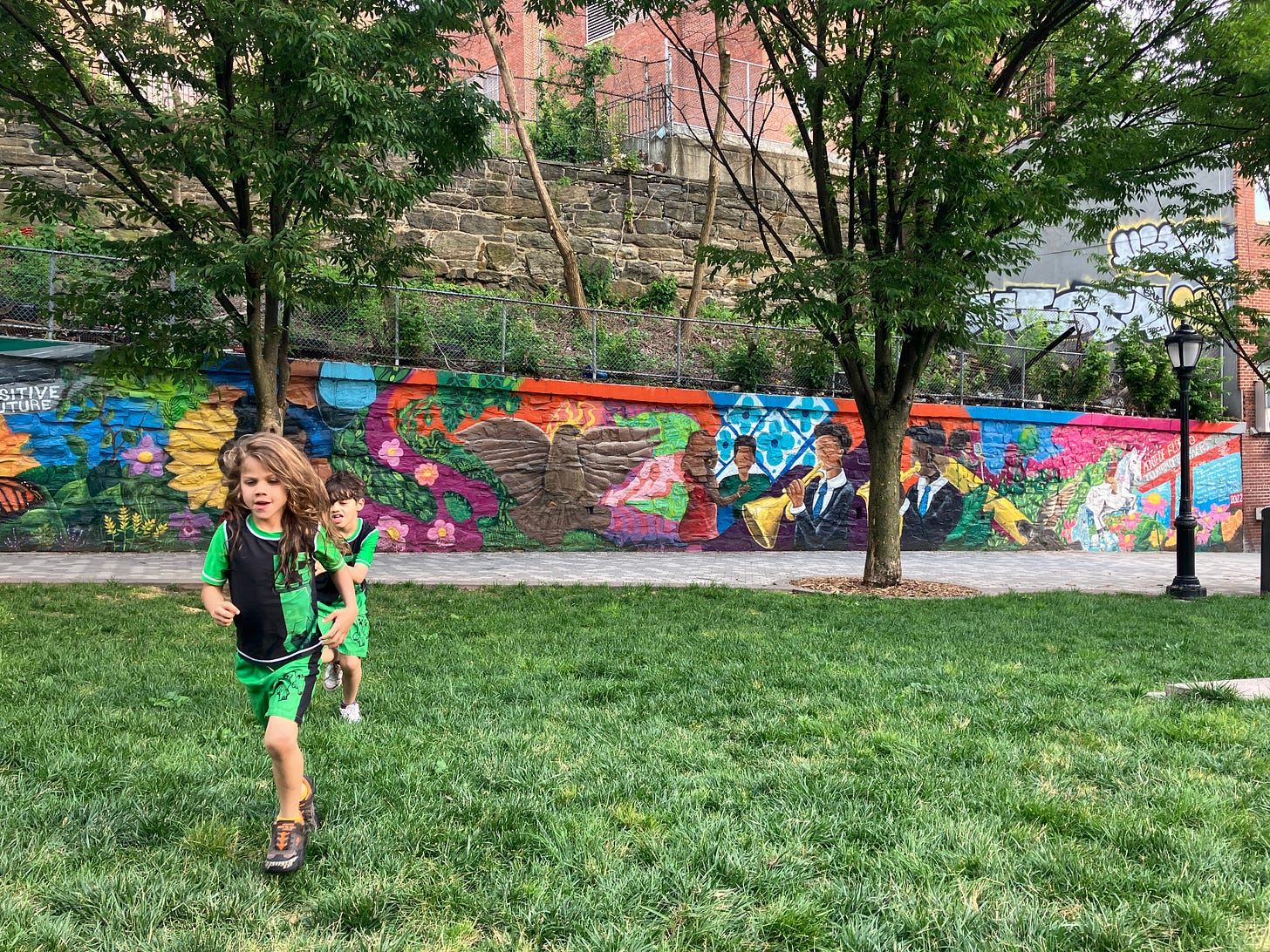
I couldn’t help but smile yesterday when my youngest son Virgil and I walked past an icon of John Coltrane outside a playground in New York. If you leave your mark on civilization, the least civilization can do is to display that mark prominently for all to see. Under the circumstances, Virgil’s t-shirt seemed the most fitting attire—Green Lantern, Superman, Batman, Flash, and Trane.
I grew up in Richmond, Virginia, where—until recently—statues mythologizing Confederate generals patrolled Monument Avenue, the city’s main drag. One of the key themes of the story I’m researching on the rise of jazz education institutions in Richmond is the dissonance between public displays of white supremacist ideology and the growing prominence of Black cultural flourishing in public arts and education between 1971 and 1989. See, for a visual example, my comparative photographs below of Frederick Moynihan’s J. E. B. Stuart monument and Kehinde Wiley’s Rumors of War:
In another striking example, Richmond trombonist and educator Charles Newton told me about how educator Johnny Peyton’s Renaissance Big Band played the first two years of Richmond’s Easter Parade: “I think the band was setup under the J. E. B. Stuart statue.” Perhaps whoever designed the parade route was a closet anti-racist? Or, more likely, at the time you simply couldn’t toss a cigar in Richmond without hitting a Confederate monument. Yet, jazz flourished during two decades of school desegregation there. Like I said, dissonance.
“The Ku Klux Klan used to march through my town.”
—Charles Newton, Richmond trombonist, bandleader, and teacher
Public monuments, images, parades, concerts, the names of places and people—these all matter in an educational sense as we grow up and learn to make sense of the world around us. My son’s middle name, Garrison, comes from the imperious Coltrane quartet bassist Jimmy Garrison. Virgil’s older brother Percy—pictured below as a two-year-old to the left of a photo of Jimmy Garrison and his son Matthew—is so named after the elder Heath brother, bassist for the Modern Jazz Quartet.
“I've been in New York for 33 years. You know what? Every time I saw Jimmy [Heath], he remembered those days at VCU. He always talked about it. And I'm talking about up until he passed away, up until just recently. He'd say, "Man, I remember we came down there..." Because you know, they came twice [the Heath Brothers band with Percy on bass and Albert on drums]. They loved it so much the first time, they asked to come back a second time.”
—Steve Wilson, saxophonist and educator who studied music in Richmond at Virginia Commonwealth University (VCU)
In my house, family conversations about names often require dropping the needle on A Love Supreme or Django. How many enlightening conversations will result from displaying Coltrane’s likeness on city playgrounds? Every time my kids and I walk down West 135th Street to the Harlem YMCA for basketball or swimming, we end up talking about a funny man named Dizzy and listening to “Salt Peanuts.” We can’t help it. We practically step on the poor guy.
As I prepare to say goodbye to my kids for a few weeks while they travel abroad with their mom, I reflect on the beautiful cultural and educational opportunities all around us in this crazy, dissonant metropolis. Just Saturday, we strolled by a concert in our neighborhood on the way home from the park and had the pleasure of hearing Craig Holiday Haynes on drums. His father Roy also played with Trane and gave his son a middle name honoring musician Billie Holiday. What we say and do now echoes down the years.
Monuments, oddly enough, are all about tomorrow. That’s the question. These icons already left their mark on our shared world. But who will you be, my sons? Perhaps some of the world’s greatest heroes.







